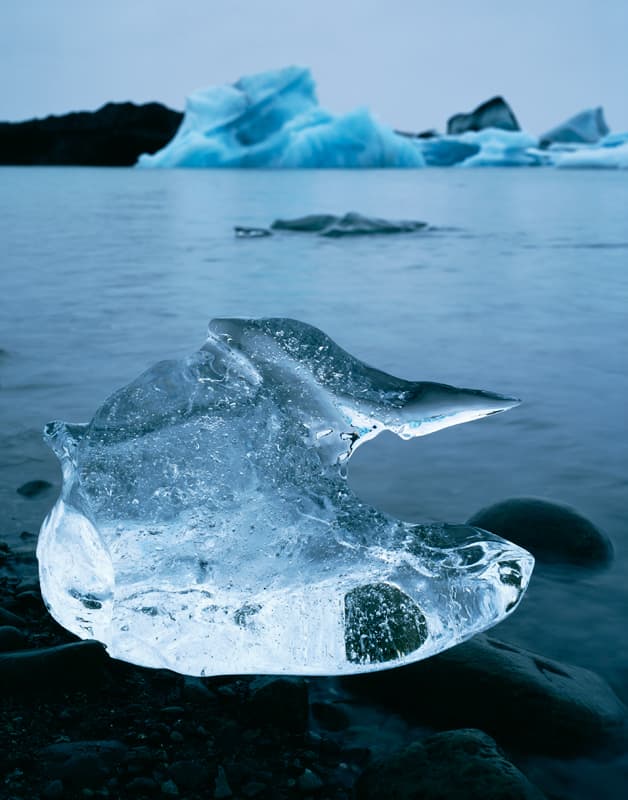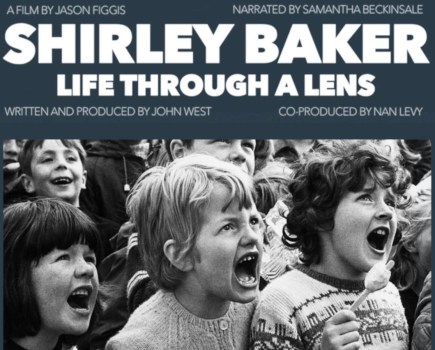Photo Insight with David Ward

David Ward is one of the UK’s finest landscape photographers. With more than 20 years’ experience in large-format photography, he has photographed extensively throughout the UK and in countries such as Canada, Iceland, Norway and France. He has also led workshops for Light & Land. David has written two books on his photographic philosophy called Landscape Within and Landscape Beyond. Each month, he will discuss the story behind one of his fantastic landscape photographs
This picture was taken in 2004 at Jökulsárlón, a large glacial lagoon in southern Iceland. It shows part of an iceberg that had washed up on the shore, melting to leave behind this piece of ice that was about two-feet high.
I was fascinated by the way the light was being caught within the ice, as the sky was reflected across the bottom part of it, which in turn lit up the rest with this luminescent glow. I was also drawn to the way that there is a distorted reflection of the blue iceberg in the background locked within the pointed piece of the ice.
I didn’t need to light this image artificially – I never use artificial light anyway – so what you see is exactly as I shot it. However, it was tricky to work out the exposure and I had some issues with the focus.
I was using a 5x4in large-format film camera, and from memory I guess I would have looked at the brightest part of the light in the ice and worked out my exposure backwards from that. So my thought process would have been that because I wanted the ice to be rendered light, I would have placed it 1 stop or 11⁄3 of a stop above my final exposure, and then seen where all the other values fell within the image, making sure that nothing was drastically underexposed or overexposed. The image was taken at around noon on a very miserable drizzly day. I remember the weather being foul, but it frequently is at this location because you’re in the shadow of an ice cap, so it’s notorious for bad weather. However, it suited the subject because it wouldn’t have worked in bright sunlight – it needed the sombreness of that light.
When I first tried to make the image I wanted it to be sharp all the way through, but you can see that the iceberg in the background is out of focus. From experience, I worked out that I couldn’t get the entire picture sharp, as the camera and lens I was using wouldn’t allow both the background and the piece of ice in the foreground to remain sharp, as the ice is quite close to the camera. I therefore decided it would be much better for the ice in the foreground to remain sharp against a softer background, as it would stand out a lot more. So I ultimately decided to go for a wider aperture to throw the background out of focus, and a wide aperture in 5x4in camera terms is about f/16.

I was using a 150mm lens, which is standard for a 5x4in camera. The 150mm lens creates what is called an even field of illumination. The light doesn’t fall off towards the edges, so consequently the sky is evenly lit all the way across. The ice itself had a natural luminosity – it looked like it was glowing from within – so I didn’t need to use a lens that would have created a brighter centre-spot effect, such as a 72mm.
I also added a 1-stop grad filter over the sky and iceberg in the background, because otherwise the iceberg would have appeared too light and I wanted it to be a nice rich saturated blue.
I chose to shoot this image in a portrait format because I make 80-90% of my images as portraits and it felt natural to me. I suppose originally I must have thought, ‘Why do landscape scenes have to be shot in a landscape format? Why not shoot them as uprights?’ In fact, I’ve become more and more in love with the upright shape – I think it has a kind of restraint about it. I believe this started because when you shoot a wide landscape scene with a 5x4in camera and a wide lens, an upright orientation allows you to shoot everything from right at your feet all the way through to the distant landscape and get it all sharp. It gives a real sense of depth through the image.
What you see with this picture was created entirely in-camera. Post-processing, I just scanned the negative and adjusted it to make it look as near to the original as possible. One of the things I try to do with my photographs is to present something to an audience in as straightforward a way as possible, and simply say, ‘Look: this is just amazing’. That’s what I felt about this scene when I saw it, as I wanted to show the luminosity, the light caught in the ice and the colours of the iceberg in the background reflected in that little spike. For me, it was about the beauty of the light – that light caught within the piece of ice, which I was just trying to bring to people’s attention.
David Ward was talking to Jade Lord
To see more of David’s images or to book a place on one of his workshops, visit www.into-the-light.com







